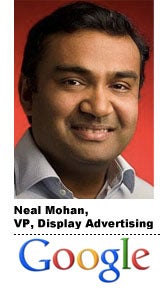 Google’s offering in the ad viewability space has scored third-party accreditation from the Media Ratings Council.
Google’s offering in the ad viewability space has scored third-party accreditation from the Media Ratings Council.
Google joins others who have wended through the MRC’s approval process – the respective viewability products from comScore, Double Verify and RealVu have been approved – so Google does not stand alone. But given its expansive relationship with marketers, agencies and publishers, the MRC’s nod at Google’s viewable offering is likely to spur more usage of this tool.
“Viewability is the first critical building block; no other metric matters, from a brand’s perspective, if the ad wasn’t seen by an actual human being,” said Neal Mohan, Google’s VP of display, in an interview with AdExchanger. “Anything that we build on top of that, such as brand lift, as we announced with our Google Consumer Surveys product, follows from that first step of knowing if an ad has been viewed.”
Publishers are wary of the trend. Traditionally, sellers have benefited from the mystery of what has been viewed and what hasn’t. Google argues there’s a silver lining in that ads below the fold may be undervalued. Since more and more users find content through search or social media, viewability promises to place content and attached ads in places other than the top of the homepage, meaning that placements once considered out of the way could command higher CPMs.
“Viewable impressions inherently command a much higher price,” Mohan said. “By giving brand advertisers more confidence, we grow the pie rather than trying to grab dollars from somewhere else. This is how we crack what I call the ‘$200 billion nut’ in brand spending for online.”
As a sign of how important Google values viewability, ActiveView will be more fully integrated into ad management systems for both buyers and sellers. Instead of using it for after-the-fact reporting, Google intends ActiveView to be “real-time and actionable.”
“It will be baked natively in all of our ad platforms, into its buy-side ad servers like DoubleClick For Advertisers and its sell-side tools like DoubleClick For Publishers, and so it won’t require any additional work by Google’s clients on either side,” Mohan said.
But how much does MRC accreditation really matter? A lot, according to Brian Hughes, SVP, Audience Analysis Practice Lead for Magna Global.
“We take MRC accreditation very seriously; it means that the methodology has been audited by a neutral third party (such as Ernst & Young or PwC) and deemed to meet the standards established by the MRC and agreed upon by industry stakeholders,” Hughes said. “Think of it as the ‘Good Housekeeping Seal of Approval’ for media research.”
As for viewability – it’s important because it’s possible, Hughes said. “To this day, we don’t know whether TV viewers are in the room 100% of the time when an ad runs,” he said. “While not foolproof, viewability in digital media allows us to at least know whether the ad was visible on screen, and we can pay for only those occurrences…The idea is to eliminate waste.”
Meanwhile WPP Group’s Neo@Ogilvy says the significance of viewability varies depending on the campaign goals.
For brand clients, the brand message is key; therefore, viewability will continue to be a hot button, according to Managing Director Bradley Rogers. For direct response clients, where media cost is commonly linked to a direct action, viewability is of lesser importance.
“The topic relies heavily on identifying consistent methodologies in which to accurately track and measure viewability, in order to understand the impact on the impressions being sold,” Rogers said. “With publishers already finding it difficult to create content and monetize that content, any factor that could potentially impact their profitability will likely meet with a slow adoption rate.”
He added, “While agencies and clients will continue to push the agenda, Google’s success in this area will be tied to this adoption curve.”
Andrew Shebbeare, chief strategist at Essence Digital, was also cheered by ActiveView’s accreditation. Essence hasn’t been all that focused on external accreditation to date; the company’s been using viewability as a diagnostic metric more than a buying filter. But as viewability becomes more and more a metric to buy against, Shebbeare expects Essence’s stance will change accordingly.
“As I’ve said before [on AdExchanger], I’d love to see viewability metrics available from ad servers at the impression log level,” Shebbeare said. “Google is paving the way to impression-level viewability within the same measurement context as conversions and exposure, [making] our brand lift and attribution models considerably more powerful, leading to better, faster decisions.”
Google’s analysis of the strong correlation between viewability and click-through rates is interesting, Shebbeare adds. In particular, he agrees with the idea that viewability can demonstrate “gold below the fold” – a reminder that simply being at the top of a page can no longer equate with viewability.
“It’s hard to make fair comparisons, since buying ads often carries a trade-off between placement and targeting, which itself might entail a trade-off between viewability and CTR,” Shebbeare said. “For example, retargeting ads will generally have higher CTRs but might be less viewable on average than ‘premium’ ads. It’s hard to compare fairly. We find one of the more interesting relationships to be the one between viewability and brand lift. Here we repeatedly see powerful correlations – so much so that viewability has become a proven first-pass optimization metric for brand campaigns.”













